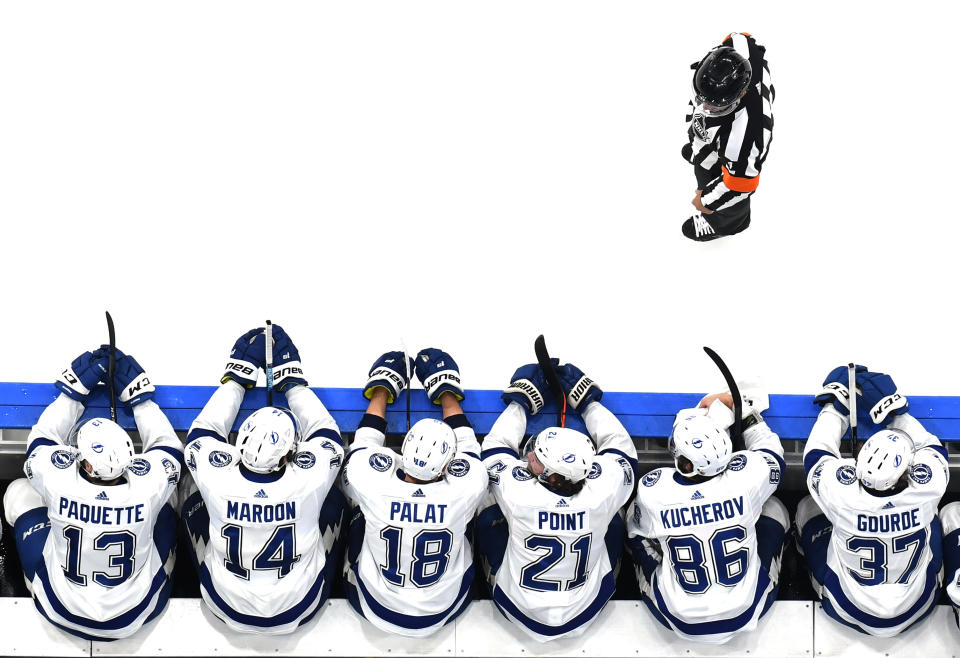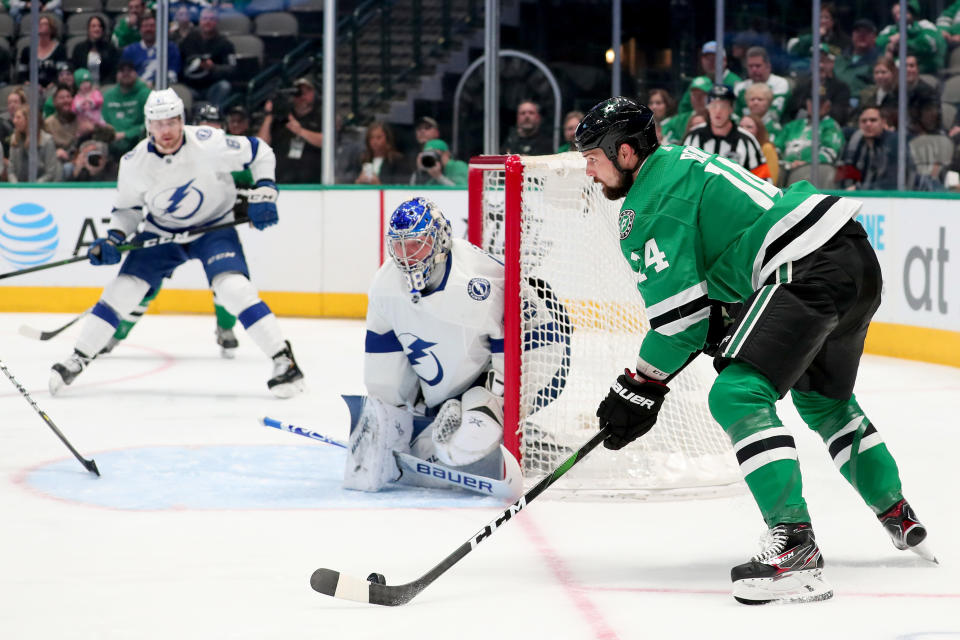How the Lightning and Stars arrived to a Stanley Cup Final like no other
Full speed ahead to the Stanley Cup Final.
Seven weeks after the first game of the qualification round in the extended Stanley Cup playoffs and an unprecedented hockey summer amid a global pandemic, the Tampa Bay Lightning and Dallas Stars will collide in Game 1 of the Stanley Cup Final on Saturday night.
It’s a matchup between two teams that have written vastly different stories on their paths to the league’s championship series, both in terms of their process as organizations and their progression through the NHL’s restart tournament.
Tampa Bay has been one of the most successful teams of the last decade, but don’t have a title to show for the fact that only one team has won more postseason games over that span. The Stars, meanwhile, have had their ups and downs over that time, largely performed at or around the league average up until this season, when all the pieces seemed to fall in place.
Whether hockey’s greatest prize is headed to Florida or Texas at the end of a tournament unlike we will ever see in the NHL again, a franchise that entered the league in the early 1990s can begin working on a second championship banner to send to the rafters in two weeks or less.
Here’s a look at how these teams arrived to this point, with a chance to win the Stanley Cup almost one year after their seasons officially began.
Their paths
Both the Lightning and Stars advanced straight into the traditional phase of the Stanley Cup playoffs by virtue of their performance in the regular season. The Lightning preserved the No. 2 seed with its 2-1 record through the qualification round, while the Stars moved up one spot to No. 3 from the last automatic berth despite failing to record a regulation win in their first three games inside the bubble.
The Lightning were without the luxury of easing into the tournament by virtue of that high seed, drawing the team that ended their historical 2018-19 season in humiliating fashion, the Columbus Blue Jackets, again in Round 1. But despite being pushed to the test in a Game 1 that extended to a fifth overtime, the Lightning earned their redemption, knocking off the Blue Jackets in five games. Then in a matchup worthy of the Eastern Conference final, the Lightning needed only another five games to defeat the Presidents’ Trophy Boston Bruins, setting up their third-round matchup versus the New York Islanders.
This time the Lightning needed six games to advance, but continued to thrive in overtime, completing a third straight series with a sudden-death winner.
On the other side, despite making things easier on themselves, the Stars fell behind early in their first-round series versus the Calgary Flames, needing a last-second equalizer from Joe Pavelski to prevent falling behind 3-1. It proved to be a key moment for the Stars, who won three straight to close out the Flames, before jumping out to a 3-1 lead over the heavily-favored Colorado Avalanche.
Dallas failed to close out the Avs with their first two attempts, but emerged from Game 7 with a win to advance to the Western Conference final against another favorite, the Vegas Golden Knights. The Stars took a 3-1 series lead once again, and this time slammed the door shut with a third period comeback in Game 5.
While the Stars were first to punch their ticket into the NHL’s championship series, they needed two extra games over the balance of these playoffs in order to reach this point. However if there is one team that might be more affected by the attritional aspect of the postseason grind, it seems to be the Lightning, who have really worn the battle, at least in recent games.

The cores
The brilliance of the Lightning over the past decade has been their ability to continue adding to their core without leaning on lottery selections. With Steven Stamkos unavailable, still, through the balance of the postseason thus far with a core muscle injury, it has never been more important that the system continues to feed that talent base.
Brayden Point, Anthony Cirelli and Mikhail Sergachev, in particular, seem to have each taken another step forward in the absence of their captain, helping the likes of Victor Hedman, Nikita Kucherov, Ryan McDonagh, Alex Killorn and Ondrej Palat carry the load.
Meanwhile the Stars have had a pretty clearly defined core for the last few years as well, with Jamie Benn, Tyler Seguin, Alexander Radulov and John Klingberg forming the team’s nucleus. It’s a collection that with the exception of Klingberg, has already enjoyed its peak seasons, but has been reinvigorated, finally, by a wave of supporting talent.
The most significant shot in the arm has been their 21-year-old stud defenseman, Miro Heiskanen, who might now be the Stars’ best player, while Denis Gurianov and Roope Hintz have helped add that extra layer of talent from up through the system.
The reinforcements
Both the Lightning and Stars made significant moves to support their foundations and shore up deficiencies in the lead up to this season and the playoffs.
In moves that seemed to be direct responses to their failures from the previous spring, the Lightning added some functional grit in a redesign of the bottom six. General manager Julien BriseBois spent first-round picks on utility forwards Barclay Goodrow and Blake Coleman, who have since paired with Yanni Gourde to form a highly-effective third line, while also signing Stanley Cup champion Patrick Maroon out of free agency.
BriseBois also canvassed the scrap heap and found two highly serviceable defensemen in Kevin Shattenkirk and Zach Bogosian, and they have played major roles on the Tampa back end while costing next to nothing.
Jim Nill was far less thrifty with his restructuring, having landed two of the most sought-after free agents available last summer. With former Stars captain Joe Pavelski signing a three-year deal worth $21 million and Corey Perry agreeing to a bonus-laden one-year deal, the Stars changed the top six dynamics and power-play formations with two former superstars and mainstays of their Western Conference rivals.
The goaltenders
The two netminders likely to be featured in the series could not be much more unalike, with the exception of their national affiliation.
Big, highly structured and an athletic freak with first-round pedigree, Andrei Vasilevskiy is the new wave of netminder, and might be the very best in the game right now in his fourth year as the Lightning starter.
Meanwhile, Anton Khudobin, 34, is an undersized journeyman who relies on instinct, has never held a feature role at the NHL level, and was only thrust into action in these playoffs after Ben Bishop went down with another ill-timed injury.
Statistically, Vasilevskiy has had the better postseason despite all the recognition Khudobin has received for his role in Dallas’s run. However the Stars’ 1B behind Bishop has thrived from the moment he entered the system, keeping a .926 save percentage in 71 appearances across two regular seasons.
The coaches
Another intriguing subplot heading into the Stanley Cup Final is the relationship between the two head coaches, Jon Cooper and Rick Bowness, who just happen to be two of the game’s most affable.
It will mark the first time that a head coach and his former assistant meet in the Stanley Cup Final, only it’s not a case of the up-and-coming bench boss stepping out on his own, and meeting the veteran head coach they once learned under. Instead, it was Cooper looking for some experience when piecing together his coaching staff in his first season as an NHL bench boss when he took over the Lightning job in 2013, and looked to Bowness.
Bowness spent five seasons with Cooper before the two split, amicably, after a conference final loss two seasons ago. Bowness was hired for a similar function by the Stars, and only took on the head coaching role, for the first time in nearly two decades, after Jim Montgomery was fired for conduct unrelated to his role as head coach.
Season series

Tampa and Dallas met twice in the regular season, with the Stars winning both games in overtime on goals from Seguin and Benn.
Postseason stats
Lightning
Goals: 61
Goals against: 43
Expected goals/60: 2.63
Expected goals/60: 2.3
CF: 55.59%
PP: 17.9%
PK: 83.6%
Stars
Goals: 61
Goals against: 63
Expected goals/60: 2.61
Expected goals/60: 3.01
CF: 47.96%
PP: 27.3%
PK: 83.3%
More NHL coverage on Yahoo Sports

 Yahoo Sports
Yahoo Sports 


